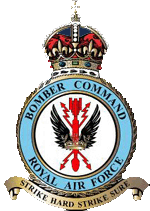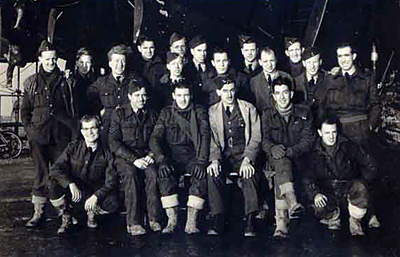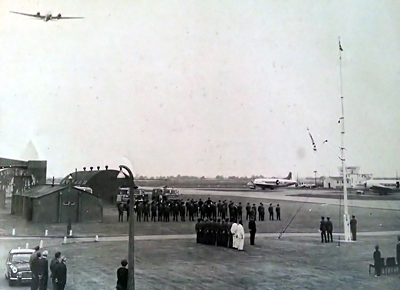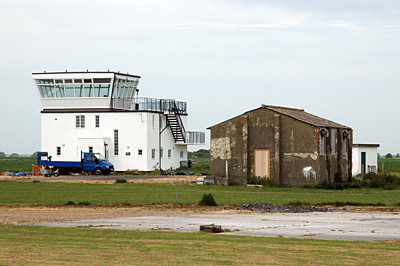Strubby Airfield History

(Map edited to show the airfield and runways 1940-45)

© Crown Copyright/MOD 2010
53°18'28.02"N 0°10'04.78"ERunways:
03/21 4410ft x 150ft - 09/27 6000ft x 150ft - 15/33 4728ft x 150ft
Strubby was a late Class A standard airfield lying some eight miles south-east of Louth directly south of the village of Strubby and within the area bounded by the A157, A1104 and B1373 roads. Three minor roads connecting Strubby to Beesby and Claythorpe were closed soon after construction started in 1943. The 36 hard standings were all loop type and hangars two type T2s on the technical site near Woodthorpe House, and a B1 on the east side between runway heads 27 and 33. The bomb store was beyond the north side, east of runway head 15 and west of Strubby village. Most domestic sites were dispersed in Woodthorpe parish allowing accommodation for 1999 males and 402 females.
Originally allocated to 5 Group Bomber Command. the station was placed immediately on Care and Maintenance upon its completion. The first recorded landing at the station was by an USAAF Republic P-47 Thunderbolt. The aircraft was forced to make an emergency landing on the runway before the station had even been completed. It wasn’t until the 13th April 1944 that the station was officially opened.
Upon opening the station became a sub-station of 55 Base on the 15th April 1944. It wasn’t until the 1st May 1944, that the station got its first residents, with the arrival of No.280 Sqn, 16 Group, Coastal Command. The squadron brought with them the Air-Sea Rescue equipped Vickers Warwick. Even though the station was under Bomber Command, it was agreed that a Coastal Command should be located there due to the airfields close proximity to the North Sea.
The first Bomber Command squadrons to arrive at Strubby were No.144 Sqn and No.404 Sqn (RCAF), with both squadrons arriving on the 1st July 1944. Both squadrons formed the Strubby Strike Wing and were tasked with working alongside No.280 Sqn under the control of Coastal Command. The role of the three squadrons was to engage anti-shipping strikes over the North Sea. Their first strike was to be against a 3000 ton merchant ship off Norderney, which they managed to sink. Only a few days later they were pressed in to action again when they were part of a mass operation to attack a big convoy off Heligoland. During this operation, the Beaufighter squadrons managed to sink three ships, along with a minesweeper and an air-sea rescue launch.
The role of all three squadrons was short lived though. Only a few months later on 3rd September, both No.144 Sqn and No.404 Sqn (RCAF) left the station, with No.280 Sqn also leaving three days later on the 6th September.
The airfield was only to remain empty for a few weeks, when on the 28th September; No.619 Sqn arrived from RAF Dunholme Lodge, bringing with them the Avro Lancaster. The new squadron was pressed in to action only a few days later, embarking on their first operational mission from their new home on 4th October 1944. Their first mission was to involve five aircraft in mine-laying in Oslo fjord, sadly only four were to return. Their next two missions saw them despatch twenty aircraft on each, with all returning safely.

© UNKNOWN - No.619 Sqn - 16th December 1944
The next arrivals at the airfield were in the form of No.227 Sqn “B” Flight, when they formed at the station on the 7th October 1944. The new Flight was immediately attached to No.619 Sqn for operations, until they left the station to join “A” Flight (which had been formed at the same time at RAF Bardney) at RAF Balderton on the 20th October.
No.619 Sqn’s last operational mission of WWII was to take place on the 25th April 1945, six Lancasters despatched to bomb Hitler's residence (the Kehlsteinhaus) at Berchtesgaden in the Bavarian Alps. All aircraft attacked the primary target, with one Lancaster failing to return. The squadron's final act before VE Day, was on the 4th May 1945, when it was tasked with ferrying ex-POW’s back to the UK from Belgium.
In total Sixty-five Lancasters failed to return or were destroyed in crashes during operations from RAF Strubby, all of the aircraft were from No.619 Squadron.
The airfield was to become deprived of aircraft shortly after this, when on the 30th June 1945, No.619 Sqn left the station to take residency at RAF Skellingthorpe. With this, the ground troops of Tiger Force were moved in for kitting out, and as part of this force, No’s.381, 382, 383 and 384 MUs were formed at the airfield on the 9th July 1945. But by the start of September all had either left the airfield (No’s.382 and 383), or had been disbanded (No’s.381 and 384).
Other units to be formed at Strubby as part of the Tiger Force were 81 Mobile Field Hospital, 38 Field Hygiene Unit and the 39 Malarial Control Unit. Again by the start of September all had left the station.
With the end of WWII, RAF Strubby was placed on Care and Maintenance, and by the 1st November 1945, all flying from the station had ceased. With the closure of the station, the administration of it was transferred to East Kirkby. This in turn led to 40 Group Maintenance Command taking over the airfield as sub-site of 35 MU on the 20th November 1945, and the future of the station looked very bleak.
The maintenance unit stayed at Strubby until 29th July 1949, when it passed control of the airfield over to the RAF Flying College at RAF Manby, and it was confirmed that new life would be breathed back in to the station.
From 1951 the airfield became a Relief Landing Ground, and was used by a wide variety of aircraft now being flown by the RAFFC at RAF Manby, as the airfield was more suited to jet aircraft than Manby was. With this, the RAFFC moved a number of aircraft to the station including the de Havilland Vampire, Gloster Meteors and piston-engined Avro Athenas. Along with the newly arrived aircraft at the station, No.12 GCA Unit arrived on the 15th January 1951. But there stay was short lived and they were disbanded only a few months later on the 1st March 1951.
It was all change again the following year in 1952, with the withdrawal of the de Havilland Vampires from RAF service. But they were soon replaced in the following year with the English Electric Canberra. 1953 also saw another new arrival to the station, in the form of a visit from HRH The Duke of Edinburgh in the February. Although his visit was not entirely about the station itself, but more about the damage that had been caused to the East Coast during the floods. The following year it was more change at the airfield with the main runway being extended and an operational readiness platform built.

© RAF Manby - Final parade 8th September 1972
During July 1955, the Gloster Meteors of 3 All Weather Jet Refresher Unit arrived at Strubby, to replace the outgoing Avro Athenas from the station. Also by December the same year, the first Hawker Hunters had started to arrive at Strubby. Which in turn meant that the once run down station was now back at full capacity housing and operating Canberras and Hunters of the RAFFC, and Meteors of the AWJRU.
Up until November 1961, all personnel serving at the station were housed there, but from this date all personnel were rehoused at nearby RAF Manby, and the domestic housing site was closed down. In July 1962, the AWJRU left Strubby but was quickly replaced by personnel and aircraft from the newly formed School of Refresher Flying at Manby. At this point the RAFFC had been renamed the RAF Collage of Air Warfare and was still operating the Canberras from the airfield, but the Hunters were slowly starting to be withdrawn.
The next aircraft to appear at the airfield was the Hunting Jet Provost in March 1964. These aircraft were brought in to replace the outgoing Meteors at the station, and by April 1965 all had gone. But again, by the end of 1965, all the Jet Provosts had been replaced by the Vickers Varsity’s of the CAW.
By now the merry-go-round of aircraft at the airfield was in full swing, and yet another change was about to happen. During February 1966 the first Hawker Siddeley Dominies started to appear, replacing the now outgoing Canberra. By the time a full complement of Dominies had arrived at the station in December 1966, the last Canberra left.
Both the Canberra and Varsity aircraft were to remain at the airfield until RAF Strubby was finally closed for good on the 8th September 1972. During the final parade at the station, a single Dominie followed by a single Varsity, made farewell flypasts. These were to be the last military aircraft to be seen at the station.
On finishing there farewell flypasts, the Dominie flew straight to Manby, representing the types move there, and the Varsity straight to Oakington, representing it’s move there. Although the station was not entirely cleared of its aircraft until the following week. Soon after this, the station was closed down in its entirety.
The old airfield was to see more aviation in 1974, but this time in the form of helicopters. The former RAF station had been selected by Conoco for the site of a heliport to ferry its employees to and from their gas platforms in the North Sea. Conoco purchased a section on land on the eastern side of the airfield which included four spectacle dispersals and part of the peri-track. Along with this, they constructed a new hangar and terminal buildings.

© Richard E Flagg - The refurbished control tower 2008
The next arrivals were the Lincolnshire Gliding Club, who moved here from RAF Swinderby. On arrival the club changed it’s name to the Strubby Gliding Group, but only after a short period of time reverted back to its original name.
Over the following years the airfield used for a number of things, until the airfield was put up for auction in March 1980. Soon after the sale the runways, peri-track and dispersals were torn up to be used as aggregate on many roads around the area.
During this period both Conoco and the Gliding club continued to operate from the airfield, until 1999, when Conoco departed the airfield for it’s new home at Humberside Airport, where it still resides to this day.
Today the airfield is still very much in use, and the Lincolnshire Gliding club are still very much active at the airfield. They have now been joined by Woodthorpe Aquatics who occupy Hangar 1 on the airfield for their pet and fish business. The airfield is also home to Woodthorpe Kart Club which holds races every month and occupies a large section of the field and buildings.
Even though many of the building have long since been demolished, there is still an air about the old airfield of its long and proud past.
| Date | Squadron | Notes |
|---|---|---|
| April 1944 | RAF Strubby opened. | |
| May 1944 | No.280 Sqn | Operating Vickers Warwicks. Left Strubby on 6th September 1944. |
| July 1944 | No.144 Sqn | Operating Bristol Beaufighters. Left the airfield on 3rd September 1944. |
| July 1944 | No.404 Sqn (RCAF) | Operating Bristol Beaufighters. Left the station on 3rd September 1944. |
| October 1944 | No.227 Sqn ("B" Flight) | Operating Avro Lancasters. Left Strubby on 20th October 1944 to join "A" Flight.. |
| October 1944 | No.619 Sqn | Operating Avro Lancasters. Left the station on 30th June 1945. |
| November 1945 | 30 MU | The Maintenance Unit was the station as a sub-site until 29th July 1949. |
| July 1949 | RAFFC | The RAF Flying Collage operated the Gloster Meteor, de Havilland Vampire, Avro Athena, Hawker Hunter and English Electric Canberra. The RAFFC changed it's name to the RAF CAW in July 1962. |
| July 1955 | 3 AWJRU | The All Weather Jet Refresher Unit operated the Gloster Meteor. The AWJFU left Strubby in July 1962. |
| July 1962 | RAF CAW | The RAF Collage of Air Warfare operated the English Electric Canberra, Vickers Varsity and Hawker Siddeley Dominie. The CAW left the station on 8th September 1972. |
| September 1972 | RAF Strubby officially closed. | |
| March 1980 | Airfield put up for auction and sold-off. |
